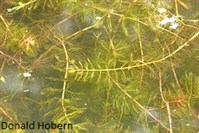Invasive - Eradicate!
Eurasian Watermilfoil (Myriophyllum spicatum) is an exotic species most likely introduced in the United Sates by the aquarium industry. It is considered one of the most aggressive and problematic plants in the U.S. because of the dense colonies which it forms. Eurasian Watermilfoil is a major nuisance aquatic plant in the US and southern Canada.

Problems
Dense stands of Eurasian watermilfoil inhibit recreational uses like swimming, boating, and fishing. Some stands have been dense enough to obstruct industrial and power generation water intakes. Eurasian watermilfoil competes aggressively to displace and reduce the diversity of native aquatic plants.
The visual impact that greets the lake user on milfoil-dominated lakes is the flat yellow-green of matted vegetation, often prompting the perception that the lake is "infested" or "dead".
Cycling of nutrients from sediments to the water column by Eurasian watermilfoil may lead to deteriorating water quality and algae blooms.
Eurasian watermilfoil has less value as a food source for waterfowl than the native plants it replaces (Aiken et al. 1979). Dense cover allows high survival rates of young fish; however, larger predator fish lose foraging space and are less efficient at obtaining their prey thereby reducing the growth and vigor of fisheries.
Plant Description
Eurasian watermilfoil is recognized primarily by its whorls of four (number can vary from 3 - 5) feather-like leaves around the stems.
Each leaf is divided into many thread-like leaflets extending from a central rib (see leaf detail). Each leaf is finely divided into paired thread-like leaflets of about the same length. There are typically 12 to 21 pairs of leaflets per leaf.
The stems of Eurasian Watermilfoil plants are weak, appearing limp when removed from the water. Each stem can grow to 7' or more. The number of stems per plant increases as the plant ages. Each individual stem branches several times as it nears the water surface, creating a dense floating mat over the surface of the lake.
Reddish flowers on leafless spikes form in mid to late season and may extend above the water surface. Dense Eurasian watermilfoil beds usually occur in water between 3 and 20 feet deep. The tops of the milfoil plants, both stems and leaves, often turn red in color. Eurasian watermilfoil can spread by seeds and fragmentation.
Hints to Identify
Eurasian watermilfoil typically has 12 to 21 pairs of leaflets. The native northern watermilfoil, with which it is often confused, usually has 5 to 9 pairs.
Common Application Questions
Q. When is the best time to treat?
A. Once water temperatures are around sixty degrees or warmer and the plants are viable. Unfortunately, EWM arrives sooner in the spring and stays longer than our native plants thus the control window is longer.
Q. How often do I need to treat?
A. This varies with EWM depending upon adjacent influences and control products. On average, two applications per season. Your treatment site results will establish their own history and hence the future predictability. Keeping good records of your application will expedite any tailoring that need to be done. Remember, we are here help!
Q. How long before I see results?
A. Generally within ten to sixteen days things will be cleared up.
| Homeowner Treatment Options |
| Aquathol K |
| Aquathol Super K |
| Clearcast |
| Hydrothol Granular |
| Navigate |
| Sonar AS |
| Sonar RTU |
| *Aquatic Biologists recommends implementing preventative management techniques and physical removal prior to, or in conjunction with treatment. |
